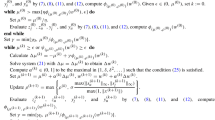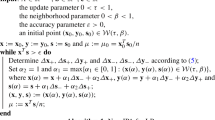Abstract
We analyze sequences generated by interior point methods (IPMs) in convex and nonconvex settings. We prove that moving the primal feasibility at the same rate as the barrier parameter \(\mu \) ensures the Lagrange multiplier sequence remains bounded, provided the limit point of the primal sequence has a Lagrange multiplier. This result does not require constraint qualifications. We also guarantee the IPM finds a solution satisfying strict complementarity if one exists. On the other hand, if the primal feasibility is reduced too slowly, then the algorithm converges to a point of minimal complementarity; if the primal feasibility is reduced too quickly and the set of Lagrange multipliers is unbounded, then the norm of the Lagrange multiplier tends to infinity. Our theory has important implications for the design of IPMs. Specifically, we show that IPOPT, an algorithm that does not carefully control primal feasibility has practical issues with the dual multipliers values growing to unnecessarily large values. Conversely, the one-phase IPM of Hinder and Ye (A one-phase interior point method for nonconvex optimization, 2018. arXiv:1801.03072), an algorithm that controls primal feasibility as our theory suggests, has no such issue.





Similar content being viewed by others
Notes
A popular misconception is that when the constraints of a optimization problem are defined by ‘physics’, MFCQ always holds. This is a nice counter-example.
References
Altman, A., Gondzio, J.: Regularized symmetric indefinite systems in interior point methods for linear and quadratic optimization. Optim. Methods Softw. 11(1–4), 275–302 (1999)
Andersen, E.D., Andersen, K.D.: The mosek interior point optimizer for linear programming: an implementation of the homogeneous algorithm. High Perform. Optim. 33, 197–232 (2000)
Andersen, E.D., Ye, Y.: A computational study of the homogeneous algorithm for large-scale convex optimization. Comput. Optim. Appl. 10(3), 243–269 (1998)
Andersen, E.D., Ye, Y.: On a homogeneous algorithm for the monotone complementarity problem. Math. Program. 84(2), 375–399 (1999)
Andreani, R., Haeser, G., Schuverdt, M.L., Silva, P.J.S.: Two new weak constraint qualifications and applications. SIAM J. Optim. 22, 1109–1135 (2012a)
Andreani, R., Haeser, G., Schuverdt, M.L., Silva, P.J.S.: A relaxed constant positive linear dependence constraint qualification and applications. Math. Program. 135, 255–273 (2012b)
Andreani, R., Martínez, J.M., Ramos, A., Silva, P.J.S.: A cone-continuity constraint qualification and algorithmic consequences. SIAM J. Optim. 26(1), 96–110 (2016)
Andreani, R., Martínez, J.M., Ramos, A., Silva, P.J.S.: Strict constraint qualifications and sequential optimality conditions for constrained optimization. Math. Oper. Res. (2018). https://doi.org/10.1287/moor.2017.0879
Andreani, R., Martínez, J.M., Svaiter, B.F.: A new sequential optimality condition for constrained optimization and algorithmic consequences. SIAM J. Optim. 20(6), 3533–3554 (2010)
Andreani, R., Haeser, G., Martínez, J.M.: On sequential optimality conditions for smooth constrained optimization. Optimization 60(5), 627–641 (2011)
Bazaraa, M.S., Sherali, H.D., Shetty, C.M.: Practical methods of optimization: theory and algorithms. Wiley, Hoboken, New Jersey (2006)
Benson, H.Y., Shanno, D.F., Vanderbei, R.J.: Interior-point methods for nonconvex nonlinear programming: Complementarity constraints. Operations Res. Financ. Eng. pp. 1–20 (2002)
Burgschweiger, J., Gnädig, B., Steinbach, M.C.: Optimization models for operative planning in drinking water networks. Optim. Eng. 10(1), 43–73 (2009)
Byrd, R.H., Gilbert, J.C., Nocedal, J.: A trust region method based on interior point techniques for nonlinear programming. Math. Program. 89(1), 149–185 (2000)
Chen, L., Goldfarb, D.: Interior-point \(\ell _2\)-penalty methods for nonlinear programming with strong global convergence properties. Math. Program. 108(1), 1–36 (2006)
Debreu, G.: Definite and semidefinite quadratic forms. Econometrica (pre-1986) 20(2), 295 (1952)
Dunning, I., Huchette, J., Lubin, M.: Jump: a modeling language for mathematical optimization. SIAM Rev. 59(2), 295–320 (2017)
El-Bakry, A.S., Tapia, R.A., Tsuchiya, T., Zhang, Y.: On the formulation and theory of the newton interior-point method for nonlinear programming. J. Optim. Theory Appl. 89(3), 507–541 (1996)
Gauvin, J.: A necessary and sufficient regularity condition to have bounded multipliers in nonconvex programming. Math. Program. 12, 136–138 (1977)
Giorgi, G., Jiménez, B., Novo, V.: Approximate Karush-Kuhn-Tucker condition in multiobjective optimization. J. Optim. Theory Appl. 171(1), 70–89 (2016)
Gondzio, J.: Matrix-free interior point method. Comput. Optim. Appl. 51(2), 457–480 (2012)
Güler, O., Ye, Y.: Convergence behavior of interior-point algorithms. Math. Program. 60(1), 215–228 (1993)
Haeser, G.: A second-order optimality condition with first- and second-order complementarity associated with global convergence of algorithms. Comput. Optim. Appl. 70(2), 615–639 (2018)
Haeser, G., Schuverdt, M.L.: On approximate KKT condition and its extension to continuous variational inequalities. J. Optim. Theory Appl. 149(3), 528–539 (2011)
Hager, W.W., Mico-Umutesi, D.: Error estimation in nonlinear optimization. J. Global Optim. 59, 327–341 (2014)
Hinder, O., Ye, Y.: A one-phase interior point method for nonconvex optimization (2018) . arXiv preprint arXiv:1801.03072
Jeyakumar, V., Lee, G.M., Dinh, N.: New sequential lagrange multiplier conditions characterizing optimality without constraint qualification for convex programs. SIAM J. Optim. 14(2), 534–547 (2003). https://doi.org/10.1137/S1052623402417699
Leyffer, S., López-Calva, G., Nocedal, J.: Interior methods for mathematical programs with complementarity constraints. SIAM J. Optim. 17(1), 52–77 (2006)
Lustig, I.J.: Feasibility issues in a primal-dual interior-point method for linear programming. Math. Program. 49(1–3), 145–162 (1990)
Lustig, I.J., Marsten, R.E., Shanno, D.F.: Interior point methods for linear programming: computational state of the art. ORSA J. Comput. 6(1), 1–14 (1994)
McLinden, L.: An analogue of Moreau’s proximation theorem, with application to the nonlinear complementarity problem. Pac. J. Math. 88(1), 101–161 (1980)
Megiddo, N.: Pathways to the optimal set in linear programming. In: Progress in Mathematical Programming. Springer, pp. 131–158 (1989)
Mehrotra, S.: On the implementation of a primal-dual interior point method. SIAM J. Optim. 2(4), 575–601 (1992)
Mizuno, S., Todd, M.J., Ye, Y.: A surface of analytic centers and primal-dual infeasible-interior-point algorithms for linear programming. Math. Oper. Res. 20(1), 135–162 (1995)
Nesterov, Y., Polyak, B.T.: Cubic regularization of newton method and its global performance. Math. Program. 108(1), 177–205 (2006)
Nocedal, J., Wright, S.: Numer. Optim. Springer, Berlin (2006)
Qi, L., Wei, Z.: On the constant positive linear dependence conditions and its application to SQP methods. SIAM J. Optim. 10, 963–981 (2000)
Rockafellar, R.T., Wets R, J.-B.: Variational Analysis. Springer, Berlin (1998)
Sonnevend, G.: An “analytical centre” for polyhedrons and new classes of global algorithms for linear (smooth, convex) programming. In: System Modelling And Optimization. Springer, pp. 866–875 (1986)
Vicente, L.N., Wright, S.J.: Local convergence of a primal-dual method for degenerate nonlinear programming. Comput. Optim. Appl. 22(3), 311–328 (2002)
Wächter, A., Biegler, L.T.: Line search filter methods for nonlinear programming: motivation and global convergence. SIAM J. Optim. 16(1), 1–31 (2005)
Wächter, A., Biegler, L.T.: On the implementation of an interior-point filter line-search algorithm for large-scale nonlinear programming. Math. Program. 106(1), 25–57 (2006)
Ye, Y., Anstreicher, K.: On quadratic and \({O}(\sqrt{n}{L})\) convergence of a predictor-corrector algorithm for LCP. Math. Program. 62(1–3), 537–551 (1993)
Ye, Y., Todd, M.J., Mizuno, S.: An \({O}(\sqrt{n}{L})\)-iteration homogeneous and self-dual linear programming algorithm. Math. Oper. Res. 19(1), 53–67 (1994)
Acknowledgements
We would like to thank the anonymous referees for their helpful feedback, and Michael Saunders for carefully proof reading the paper.
Author information
Authors and Affiliations
Corresponding author
Additional information
Publisher's Note
Springer Nature remains neutral with regard to jurisdictional claims in published maps and institutional affiliations.
Gabriel Haeser was supported by the São Paulo Research Foundation (FAPESP Grants 2013/05475-7 and 2016/02092-8) and the Brazilian National Council for Scientific and Technological Development (CNPq). Oliver Hinder was supported by the PACCAR INC stanford graduate fellowship.
Experimental details
Experimental details
The code for the experiments can be found at https://github.com/ohinder/Lagrange-multipliers-behavior.
1.1 Solvers
One-phase solver. For the well-behaved interior point solver, given a problem of the form
we can re-write the constraints as
This gives a problem of the form
which we can pass to the one-phase solver.
The terms in Fig. 2 and Table 1 are given as follows:
-
The infinity norm of the primal residual is given by \(\Vert a(x) + s \Vert _{\infty }\).
-
The infinity norm of the dual residual is measured by \(\Vert \nabla {\mathcal {L}}(x,y) \Vert _{\infty }\).
-
The infinity norm of complementarity is given by \(\max _i s_i y_i\).
-
We measure strict complementarity by \(\min _i s_i + y_i\).
The optimality termination criterion of the one-phase IPM is
For more etails on the one-phase IPM see the paper [26] and code (https://github.com/ohinder/OnePhase.jl). The linear solver used was the default Julia Cholesky factorization (SuiteSparse).
IPOPT. We use IPOPT 3.12.4 with the linear solver MUMPS. Given any generic nonlinear problem, IPOPT rewrites it in the form (by adding slacks to inequalities, see [42])
For practical reasons related to the interface we use [17], we do this reformulation ourselves. We then measure
-
Primal feasibility by \(\Vert c(x) \Vert _{\infty }\).
-
Dual feasibility by \(\Vert \nabla f(x) + \nabla c(x)^T \lambda - z_{L} + z_{U} \Vert _{\infty }\), where \(z_{L}\) and \(z_{U}\) are the dual multipliers corresponding to the constraint \(x \ge l\) and \(x \le u\) respectively (same notation as in [42]).
-
Complementarity is given by \(\max \{ \max _i((z_{L})_i (x_i - l_i)), \max _i( (z_{U})_i (x_i - u_i)) \}\).
-
We measure strict complementarity by \(\min \{ \min _i((z_{L})_i (x_i - l_i)), \min _i((z_{U})_i (x_i - l_i)) \}\).
The details of this computation can be found in the file ‘src/shared.jl’ in the function ‘add_solver_results!’.
The options chosen for the solvers are given in Table 2. We turn off the acceptable termination criterion for IPOPT to try to make the termination criterion of the algorithms as similar as possible.
1.2 NETLIB LP test details
The linear programs in the NETLIB linear programming collection come in the form \(\min {c^T x}\) s.t. \(Ax = b\), \(l \le x \le u\). Table 3 shows which solver failed on which problem.
Table 4 shows when there is a feasible solution according to Gurobi when the bound constraints are tightened by \(\delta \) i.e. find a solution to the system \(Ax = b\) and \(u - \delta \ge x \ge l + \delta \). We tried \(\delta = 10^{-4}, 10^{-6}, 10^{-8}\) and obtained the same results with Gurobi’s feasibility tolerance set to \(10^{-9}\). We found 29 problems with a feasible solution and 64 without a feasible solution in the NETLIB collection. We used Gurobi version 7.02.
1.3 Additional figures for nonconvex problems
This section gives plots of solver trajectories for the nonconvex problems of Sect. 4.2.
Rights and permissions
About this article
Cite this article
Haeser, G., Hinder, O. & Ye, Y. On the behavior of Lagrange multipliers in convex and nonconvex infeasible interior point methods. Math. Program. 186, 257–288 (2021). https://doi.org/10.1007/s10107-019-01454-4
Received:
Accepted:
Published:
Issue Date:
DOI: https://doi.org/10.1007/s10107-019-01454-4







